Health and Wellbeing, Science & SkepticismSurfer’s Ear: Say What?
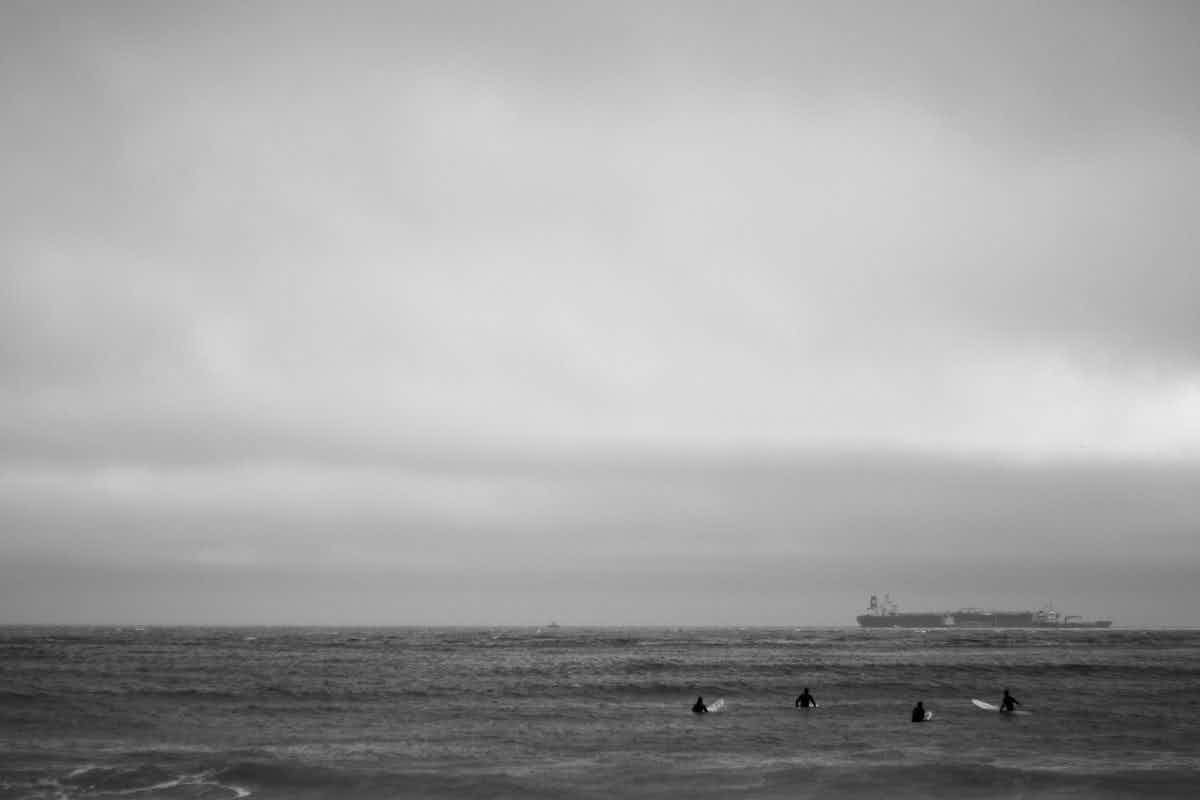
Only a select few sporting activities ever earn themselves a dedicated medical condition. The Everyday Joe or Jo can afflict themself with tennis elbow, athlete’s foot and turf toe, whilst those of us who expend our energy in the sea have the prospect of surfer’s ear to be wary of. Is this a case of the “sexy” surfing tag being hung on a medical condition in the same way it’s used to market SUVs and soft drinks, or is it an affliction that surfers are significantly more at risk of developing?
Surfer’s ear, known in the medical profession as auditory exostosis, is an abnormal narrowing of the ear canal due to the growth of boney lumps. An exostosis is a benign outgrowth of bone on the surface of an existing bone (it comes from the Greek ex- ‘out’ and osteon ‘bone’), and in the case of surfer’s ear these bone growths occur on the parts of the skull bones that form the ear canal.
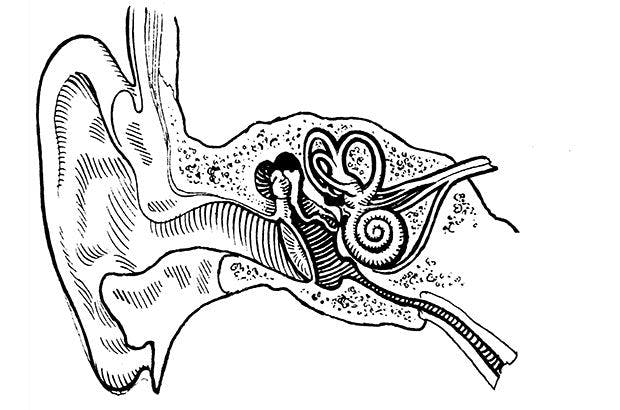
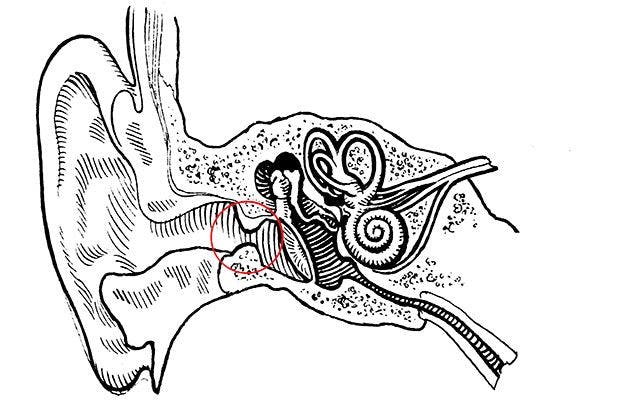
The most common cause of auditory exostosis is repeated exposure to cold water and wind over a prolonged period, which is why surfers as a group tend to be affected at a far greater rate than the general population and why the common name for the condition has been attributed to surfing. Sailors, kayakers and divers are all also at high risk of developing the condition, however in reality any situation whereby your ears are repeatedly exposed to cold, wet and windy conditions can lead to bone growths within the ear canal. Given enough time, these growths can completely close off the ear canal (an occlusion, but in the medicinal sense rather than the meteorological sense) and the patient will suffer a significant loss of hearing. It is thought that cold water entering the ears, or the cooling effect of the evaporation of water within the ear by the wind (demonstrated by instances of some surfers having more advanced exostosis in one ear over the other due to the prevailing wind direction at their local surf spot), stimulates an increased blood flow leading to increased bone growth, and that this can happen within a window as small as five years of regular surfing in cold water. Despite the fact that a surfer who frequently surfs in cold water environments could develop surfer’s ear so quickly, bone growth is a slow process and therefore most patients who present symptoms advanced enough to require treatment (prompted by noticeable temporary hearing loss or an increased frequency of ear infections) tend to be in their mid thirties or older. Are we therefore sitting on a ticking time bomb of surfer’s ear, thanks to the time required for the condition to develop and the combination in recent decades of continued mass uptake of surfing and improved wetsuit technology opening up new and much colder frontiers to surfers?
“It’s difficult to predict how quickly the condition develops, but in Cornwall where children grow up with the sea I have treated 15 year old surfers with exostosis related infection. Surgery however has not been required in anyone under 20 years of age.
The condition can be prevented by stopping the repeated ingress of cold water into the ears either with plugs or a hood. Despite this the use of protection has been poor in the UK. Our study of winter surfers’ awareness of exostosis in 2010 revealed that only 60% knew of its preventability, and only 54% used some form of protection. Knowledge of the condition was associated with a greater likelihood of using protection and I would therefore expect this figure to improve as more information is provided for the surfing population.”
Dr. Phil Flanagan – Cornwall, UK
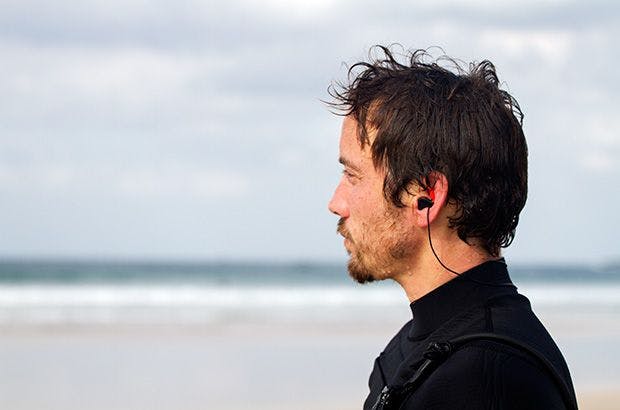
Surfer’s ear is a very real and serious problem for cold water surfers. The California Ear Institute estimates that cold water surfers develop exostosis at a rate 600% higher than surfers from warm water regions, and the surgical procedure to remove the bony growths is not a permanent fix – given time and continued exposure, they can grow back. Like the bony growths themselves, symptoms develop over time and may initially be as minor as your ears taking longer to drain. This can progress to water getting trapped in your ear (with the exostosis compounded by trapped ear wax and debris such as dead skin), which can lead to temporary hearing impairment and then irritation and infection. Surfactant drops can be used to help this water drain and preventative steps can be taken to halt the development of the bony growths, hitting the pause button on your surfer’s ear. Repeated ear infections are however a sign that you could have surfer’s ear, and the only way to find out definitively is to have your ears examined by a Doctor – preferably one based in a coastal location who will have previous experience diagnosing and treating the condition. The problem could be caused by a significant build up of earwax creating a blockage in the ear canal, or it could indeed be surfers ear to some degree. It is perfectly possible to have developed surfers ear without noticing any symptoms whatsoever, until the condition reaches an advanced stage.
“The majority of surfers with exostosis are asymptomatic and only find out that they have them when someone looks in their ear or they develop symptoms. Usually, in my experience, exostosis causes problems that progress to surgery when the ear canal is more than 90% closed.”
Dr. Phil Flanagan – Cornwall, UK
Surfers suffering repeated ear infections as a result of surfer’s ear will most likely want a more permanent and effective solution than the initial treatment of micro-suction to remove the infected pus and ear wax (performed by an ENT specialist) followed by a course of antibiotic ear drops; the very fact that there are bony growths blocking the ear canal complicates the micro-suction process by restricting access to the problem area. Eventually, the best option may be the removal of the bony growths by surgery performed under general anaesthetic. This surgery can be performed using one of two different techniques; using a small drill to remove the bony growths, or using a small surgical chisel to split the bone along its natural fracture lines (bone grows in layers so the weak joints between each layer can be exploited to carefully remove the entire exostosis). There are different approaches to the ear canal which then allow the surgeon to carefully reflect the skin lining the ear canal in flaps so that the exostoses can be removed; the traditional post-aural incision (where an incision is made behind the ear and the outer ear is reflected forward and the skin of the ear canal is dissected out of the ear canal), or the more minimal options of an end-aural incision (where an incision is made in the outer ear canal to widen the opening and improve the surgeon’s access to the deeper ear canal) or a trans-canal approach (where the only skin incisions are made in the inner ear canal directly over the bone growths). The ear canal skin flaps are replaced following the removal of the exostosis. Using a tiny drill is the traditional technique and allows the surgeon to be incredibly precise when removing bone, which is particularly important if the exostosis is sited very close to the eardrum. Chiseling utilises very small chisels (just a millimetre or so wide) and is a technique growing in popularity with ENT surgeons in the USA and UK as it is less likely to damage the skin lining the ear canal and the risk (albeit low) of hearing damage or tinnitus caused by the noise of the drill is removed.
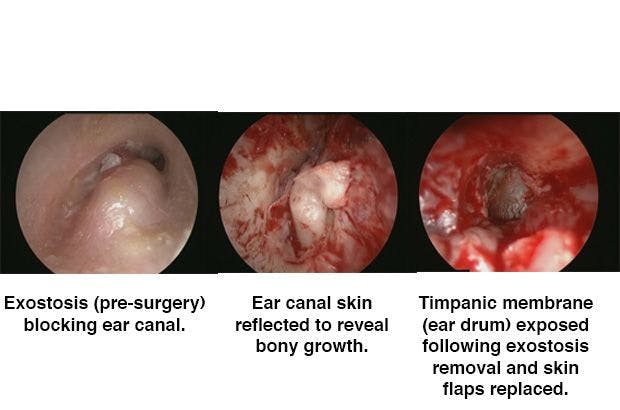
“My technique for removing the symptomatic ear canal growths of “surfer’s ear” is to have the individual under general anesthesia (totally asleep) and then approach the growths via the ear canal without making any external incisions. Typically through three incisions in the depths of the ear canal, the skin overlying the bone growths is peeled away to expose the underlying bone, and the removal of the bone is then done with 1mm straight and curved chisels and small bone curettes (small versions of an ice cream scoop). When adequate contours are achieved, the skin is replaced in anatomic position and antibiotic ointment is applied over the incisions.
My motivation in developing this technique was to remove bone growths without subjecting individuals to the noise of drilling in the ear canal. I also found that by using chisels and curettes in this way, the delicate skin lining the ear canal (the thinnest skin in the body) was more easily protected and suited to rapid healing.
After surgery, patients are directed to keep water out of their operated ear(s); are seen at weekly intervals for cleaning of blood clots and crusts; and are allowed to resume full water activities when the ear canal skin is well-healed with no crusts (typically 3-4 weeks after surgery). I have used this technique in over 1900 ears over the past 18 years and I and my patients are happy with the results.”
Dr. Doug Hetzler – Santa Cruz, California
“An ounce of prevention is worth a pound of cure”
Benjamin Franklin
If you surf regularly in cool, cold or windy conditions, take steps to protect your ears. Wear a neoprene hood when it’s really cold, and wear ear plugs. Ear plugs don’t have to keep your inner ear completely dry, they simply need to stop cold water from flushing in and out of your ear canal. If water gets into your ear canal and stays there then it will be warmed to body temperature and won’t cause you problem – it is the constant flushing and evaporation of cold water that causes the problem. Many budget conscious surfers form ear plugs from the adhesive putty used to temporarily stick posters to walls, however there are now many different ear plugs available to surfers that protect the ears without hindering hearing or balance (the two most common complaints that cause surfers to give-up on wearing ear plugs) and that come in a range of sizes to ensure a snug and comfortable fit whilst reducing the chances of them falling out. The greatest hurdle in the battle against surfer’s ear is simply that most surfers will not address the problem until it is a problem, at which point it could be too late.
“Surfer’s ear (exostosis) is a condition that, in years to come, we should see less of as knowledge of it and its preventability amongst surfers improves. Counterbalancing that however is the surge in popularity of surfing. It is crucial therefore that surf journalists and physicians work together to get the message to the surfing community.”
Dr. Phil Flanagan – Cornwall, UK
In an ideal world ear plugs would be as essential a part of a cold water surfer’s kit as a wetsuit, surfboard, fins, leash, and a towel – but less shareable than wax. If you keep all of these things in a tub in the trunk of your car, then there’s no good reason not to also have a set of ear plugs in there as well, so that you won’t have to go under the surgeon’s knife in years to come and sit out on the beach watching your friends score good waves whilst your ears heal.
For expert medical advice regarding the diagnosis and treatment of auditory exostosis in the USA and UK: